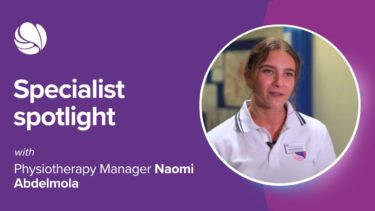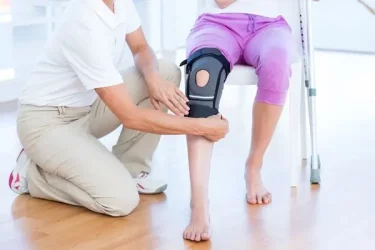Estimated reading time: 6 minutes
Our knee replacement surgery recovery guide offers practical tips for a successful recovery. Read on for more information on how you can enjoy a full and speedy recovery.
Knee replacement surgery is a common procedure used to relieve pain and restore mobility for those with knee joint damage. This guide provides valuable information and tips to help you navigate the postoperative period and get back to a better quality of life.

Private knee replacement surgery at a glance
- Waiting time: 4-6 weeks
- Cost: £13,149
- Ways to pay: self-pay or insured
- Hospital stay: same-day or in-patient
- Procedure time: 1-3 hours
How long does it take to recover from knee replacement surgery?
The time to recover from knee surgery varies from person-to-person. It depends on a range of factors including:
- age
- overall health (i.e. fitness and activity levels)
- the complexity of your knee problem
- how closely you follow the rehabilitation plan.
Most patients will see a significant improvement in their knee function by 12 weeks. However, a full recovery can take up to 18 months. It is important to follow your post-operative programme as it will help you make a speedy and full recovery.
With that said, most patients will be able to start resuming some normal activities within six weeks of surgery.
Knee replacement recovery timeline
Here’s a step-by-step guide breakdown of what patients can expect during their recovery process.
Before knee surgery
To ensure a smooth recovery, it’s important to prepare your home in advance. Be sure to make your living area safe and comfortable. You can do this by removing trip hazards, arranging supportive seating, and installing handrails if needed.
It’s also worth making a rehabilitation plan before your knee surgery. Talk to your surgeon and physiotherapist to understand what’s involved and do what you can to mentally and physically prepare for the recovery period.
Recovering from knee replacement in hospital – first few days post-surgery
After surgery, you will be transferred to the recovery room and then to a hospital room. The length of hospital stay varies but is usually a few days. During this time, you will be closely monitored and rehabilitation will begin.
At Practice Plus Group, we practise the Enhanced Recovery Pathway (ERP). This is a modern, evidence-based approach that helps people recover quickly from major surgery.
Our physiotherapists begin working closely with you within hours of knee joint replacement. Early mobilisation and a return home reduces the risk of deep vein thrombosis and infections. It can also make you feel more comfortable.
When you’re feeling ready, a physiotherapist will come and help you stand up. You’ll be encouraged to walk a short distance using a supportive device. They will also show you how to safely perform some everyday tasks and movements.
It may seem a little early, but moving around can help to reduce the risk of blood clots and infections.
At this early stage, while it’s important to work on bending and straightening your knee, rest is equally crucial. Make sure to stop your exercises if you feel too much pain, and get plenty of sleep.
With this support, you will be mobile enough to go home two to three days after your operation. Your physiotherapist will be given home exercises and instructions on how to use mobility aids such as crutches and sticks. Please note that if you are specifically having day surgery knee replacement, you will usually be discharged on the same day.
You will likely experience some knee pain and discomfort after the surgery. The medical team will provide pain medication to keep you comfortable. Be sure to take the prescribed medication as directed and inform the healthcare staff if you have any concerns.
Over the next few days, you’ll be encouraged to step up your mobilisation. This will incorporate walking and practising your everyday activities.
At this stage, you should be able to stand unassisted, start to walk without the help of crutches or a frame, dress and bathe yourself and go on longer assisted walks.
Recovering from knee replacement surgery at home – first six weeks
Your recovery continues from the comfort of your home.
You will need to rest when you return home and will likely feel tired in the first six weeks. Despite this, you will need to find a balance between rest and making sure you follow your rehabilitation programme.
You will gradually begin walking with the aid of a walker or crutches. Physiotherapy sessions will start in order to regain knee mobility and strength.
As the weeks go by you should notice your pain lessens and your range of movement improves. By the second or third week after surgery, you may be able to get around with just a walking stick or nothing at all.
During this period, you may experience swelling and discomfort. This should gradually improve.
Initial recovery phase – three months after surgery
By 10 to 12 weeks, most patients are doing well. You will likely be experiencing significant improvements in pain and mobility.
Physiotherapy will continue, and you will progress to more challenging exercises. This is to further strengthen the knee while improving mobility and function.
During this time, most patients are able to walk with minimal assistance. Some may no longer require walking aids at all.
This is the point where you may want to introduce some new exercises. Swimming, walking or cycling after a knee replacement can be very beneficial. Just be sure to check with your physiotherapist or medical professional first.
You should be able to drive again around six-eight weeks after surgery.
Mid-term recovery – six months after surgery
Around this time, many patients see substantial progress in their knee function. Pain and swelling should continue to decrease. You should also be able to perform daily physical activities with greater ease.
Your physiotherapist may introduce more dynamic exercises and activities to enhance knee stability and flexibility.
Late recovery phase – one year after surgery
By this stage, you should have achieved a significant level of recovery. Most patients are capable of engaging in low-impact activities, such as cycling or swimming. The vast majority are back to performing regular tasks comfortably.
You may still notice minor improvements in strength and flexibility during this period.
Long-term recovery from knee replacement
Beyond the first year, your knee will continue to improve gradually, but progress may be less noticeable.
It’s essential to maintain an active lifestyle to support the long-term health of your knee replacement. With proper care and lifestyle choices, your knee replacement can last for many years, providing improved function and quality of life.
Knee replacement surgery – at a glance
Knee replacement surgery recovery – time off work
The amount of time before you can return to work will vary depending on the following factors:
- your job type
- the physical demands of your work
- the extent of the surgery
- your individual recovery progress.
If you have a sedentary job that involves minimal physical activity, you may be able to return to work within four to six weeks. For jobs that involve light physical activity (such as standing or walking occasionally) you may need approximately four to six weeks of time off. If your job involves heavy lifting, repetitive bending, or extensive physical exertion, you may require a more extended period of time off. This can typically last between three and six months.
Discuss your specific situation with your surgeon and follow their recommendations.
Driving after knee replacement
The timing for resuming driving after knee replacement surgery varies depending on individual factors. You should also follow the specific guidelines provided by your surgeon. In most cases, patients can start driving again six weeks after surgery.
Consult with your surgeon regarding when it is safe to resume driving.
Knee replacement recovery times for elderly patients
Older patients are more likely to experience slower healing, reduced mobility, and poorer health compared to younger patients. These factors can mean recovery is slower, but the overall health and mobility of the patient will play a big part.
It’s important for older patients to follow their surgeon’s advice. They should attend all follow-up appointments and do regular physiotherapy to achieve the best possible outcome after partial or total knee replacement surgery.
Pain in your knee?
If you’re experiencing knee pain, try our knee suitability quiz. It will give you an idea of whether you’d benefit from booking a consultation with one of our knee specialists.
How to recover from a knee replacement
Congratulations! If you’re reading this, it’s likely you’ve either just had your knee replaced or have decided to have surgery. You’re probably wondering about knee replacement surgery timings and what the healing process looks like. So, let’s take a look!
Recovering fully from knee replacement surgery requires patience, dedication, and a structured rehabilitation plan.
Knee replacement recovery tips
Your recovery is really important, so it’s important to avoid common mistakes after a knee replacement. The following tips will give you the best chance of making a full recovery:
Use a walking aid
You may need to use an assistive device, such as crutches or a walker to get around. As you regain strength and stability, you can transition to using a cane or even walk unaided. Consult your surgeon or physiotherapist beforehand.
Proper wound care
Follow your surgeon’s instructions for wound care. Keep the incision area clean and dry. Report any signs of infection to your healthcare provider.
Relieve swelling
Swelling is normal after knee replacement surgery. Elevating your leg or applying ice packs to the surgical site can help reduce swelling and provide pain relief. Follow your healthcare provider’s recommendations.
Attend follow-up appointments
Attend all scheduled follow-up appointments with your surgeon and physiotherapist to monitor your progress and address any concerns or questions you may have.
Prioritise rest and sleep
Allow yourself ample rest and sleep to aid in the healing process.
Do rehabilitation exercises
Continue with the prescribed exercises at home to improve strength, flexibility, and knee function.
Manage pain
Follow your surgeon’s instructions regarding pain management. This includes the use of prescribed medications or other recommended methods.
Return to activity gradually
Take your time when resuming daily activities. Increase activity levels gradually, avoiding excessive strain on the knee joint.
Prepare your home
Make necessary modifications to your home to ensure a safe recovery. Remove trip hazards, secure rugs, install handrails or grab bars and ensure that your living space is easily accessible.
Avoid high-impact activities
Activities such as running and jumping should be avoided. These put too much strain on your knee joint.
Avoid sitting or standing for long periods
It’s important to practise gentle movement at regular intervals to improve mobility. Follow the advice of your physiotherapist.
Did you know?
More than 95% of knee replacements last for at least 10 years, with around 80% still working after 15 years1.
How to stay fit while recovering from knee surgery
Staying fit while recovering from knee surgery is essential for maintaining overall health and aiding the healing process. Although your activities may be limited during the recovery period, there are several ways to stay active and promote fitness:
- physiotherapy plays a crucial role in your recovery. You will start with gentle exercises and gradually progress to more challenging ones as you regain strength and mobility. Your physiotherapist will guide you through exercises to improve your range of motion, strengthen the muscles around the knee and help you walk properly
- shortly after surgery, you’ll be encouraged to start walking with the help of walking aides. The amount of weight you can put on the operated leg will be determined by your surgeon or physiotherapist. As you progress, your weight-bearing activities will gradually increase in frequency and intensity
- pay attention to any discomfort or pain during exercise. If an activity causes discomfort or swelling, modify or stop the exercise and consult your healthcare provider
- stay active in daily life. Engage in light activities around the house or perform seated leg exercises while watching TV to keep your muscles engaged.
Always consult your healthcare provider before starting any new exercise routine during knee surgery recovery. Remember that the key is to start slowly, listen to your body, and gradually increase the intensity of your exercises as your knee heals and gains strength.
Best knee replacement recovery exercises
The following is a list of exercises aimed at strengthening your knee during recovery:
- Upper body and core exercises: While lower body movements may be restricted initially, you can still work on strengthening your upper body and core muscles. This can include exercises like seated shoulder presses, bicep curls, tricep dips, and abdominal exercises
- Seated exercises: Many exercises can be adapted to a seated position. These include seated leg lifts, ankle circles, and seated marching. These exercises help maintain circulation and muscle tone in the legs without putting excessive strain on the knee
- Swimming: Once your healthcare provider approves, swimming is an excellent low-impact exercise for knee recovery. The buoyancy of water reduces joint stress while providing a full-body workout
- Stationary cycling: Cycling after a knee replacement can help improve knee mobility and strengthen the surrounding muscles without putting too much pressure on the joint. Stationary cycling also removes the risk of falling off
- Walking: As you progress in your recovery, your healthcare provider may recommend walking as a low-impact exercise. Start with short walks and gradually increase the distance and intensity as your knee heals
- Range of motion exercises: Regularly perform gentle range of motion exercises such as ankle pumps and knee bends. These will help to maintain flexibility and prevent stiffness.
What to eat when recovering from knee surgery
Proper nutrition is crucial for healing and maintaining overall health. Focus on a balanced diet with plenty of fruits, vegetables, lean proteins, and whole grains. Ask your health provider for personalised nutrition advice.
When to seek medical help
Although total knee replacement is a common surgery with a high success rate, it’s important to notify your health provider if you notice any of the following symptoms:
- Infection: increased redness, swelling, warmth or discharge from the incision site
- Blood clots: symptoms include leg pain, swelling, or redness
- Implant problems: although rare, issues with the artificial knee joint may occur. If you experience persistent pain, instability, or unusual sounds or sensations in your knee, consult your surgeon
- Worsening symptoms: if your pain, swelling, or knee function declines or fails to improve over time, contact your healthcare provider for further evaluation.
Recovering from a knee replacement requires patience, commitment, and active participation in the rehabilitation process. By following this recovery guide and the advice of your healthcare team, you can optimise your recovery while regaining mobility and function in your knee.
Sources and references
Wellsoon private healthcare
Wellsoon is a service from Practice Plus Group that provides a range of treatments for patients paying for themselves or paying by private medical insurance. With no hidden costs, you’ll pay less than you might think and be back to your best sooner than you thought.
- £95 consultation within 1 to 2 weeks* – includes x-ray, bloods and swabs
- Surgery in just 4 to 6 weeks*
- Experts in hips, knees, eyes, hernias and more
- Pay for yourself or via health insurance
- 0% finance options available

Knee replacement recuperation FAQs
Still haven’t found what you’re looking for? Our knee replacement recovery FAQs may be able to help.
The average time to recover from knee replacement surgery varies. In general, most patients can expect recovery to last up to six months.
The duration of bed rest after knee replacement surgery is relatively short. Most patients are encouraged to get up and start moving as soon as possible after the procedure. Early mobilisation is essential for preventing complications such as blood clots and reducing the risk of stiffness in the knee joint.
Generally, most patients can begin walking with improved stability and comfort between two to six weeks after knee replacement surgery.
Climbing stairs is typically encouraged as part of the rehabilitation programme. In the initial days after the procedure, your knee will be swollen, painful, and weak as it starts healing. Performing activities that put significant stress on the knee joint – such as climbing stairs – can be challenging but will be encouraged.
Yes, and doing so can have negative consequences on your recovery. While walking is an essential part of the rehabilitation process, overdoing it can lead to various issues.
After knee surgery, sitting on the toilet requires some adjustments for safety and comfort. Use assistive devices like a raised toilet seat or commode chair with armrests. Please note that Practice Plus Group does not supply assistive equipment following your surgery.
Position your surgical leg slightly forward while lowering yourself onto the seat. Hold onto grab bars for support and maintain proper posture while sitting. Slowly lower yourself and use your non-surgical leg for support when getting up.
After knee surgery, you should be able to take a shower straight away. Use a shower chair or stool to sit on during the shower to prevent slips or imbalance. Keep the incision site dry until it is safe to let water contact it.
Please note that Practice Plus Group does not supply assistive equipment following your surgery.
The pain experienced during knee replacement surgery recovery varies from patient-to-patient. While some individuals may experience significant discomfort, others may have a milder recovery experience. It’s important to note that knee replacement surgery is a major procedure, and some level of pain and discomfort is expected during the recovery process.
At Practice Plus Group, we follow the Enhanced Recovery Pathway (ERP). This is a modern, evidence-based approach that helps people speed up their recovery following major surgery. The ERP champions the many advantages of day surgery knee replacement. With this support you will be mobile enough to go home on the same day of surgery, or soon after.
Painkillers in the form of anti-inflammatories are administered upon discharge from hospital. This is to help with pain relief and to manage pain and swelling.
Getting up on your feet earlier can help to speed up the recovery process, as long as it’s done carefully and safely. Your physiotherapist will give you safe exercises to practise at home in the weeks and months after surgery.
The most difficult time after a knee replacement is the first week. During this time, your knee will likely be swollen, inflamed, and painful. This can be managed by prescribed painkillers and rest.







